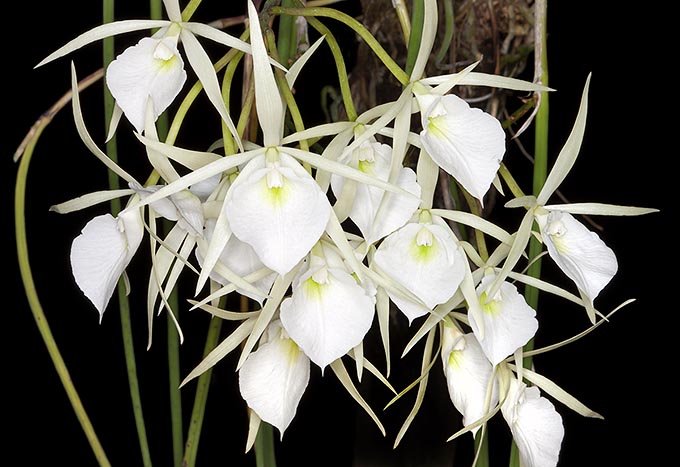Family : Orchidaceae

Text © Pietro Puccio

English translation by Mario Beltramini

Easy to cultivate, Brassavola flagellaris gets its name from the thin long leaves, similar to flagella © Giuseppe Mazza
The species is native to Brazil (Espirito Santo, Minas Gerais, Paranà, Rio de Janeiro, Rio Grande do Sul, Santa Catarina, Sao Paulo and Trindade), where it grows on the branches of the trees and on the rocks up to about 800 m of altitude.
The genus is honoured to the Italian physician and botanist Antonio Musa Brassavola (1500-1555); the Latin name of the species, “flagellaris” = equipped with flagellum, whip, refers to the long, thin, leaves.
Common names: whip-leafed Bras- savola, whip-leaf orchid (English); munida de chicote (Portuguese-Brazil).
The Brassavola flagellaris Barb. Rodr. (1882) is an epiphytic or lithophytic species with cylindrical pseudobulbs, of a length of 20-25 cm and a diameter of 0,5 cm, carrying on the apex a single rigid, cylindrical leaf deeply grooved and pointed at the apex, long up to about 50 cm with a diameter of 0,4 cm.
Arcuate, racemose inflorescences, up to about 15 cm long, carrying, on a long peduncle, 2-15 flowers of pale yellow colour, excepting the white labellum with a yellow-green dot at the base; the flowers, in spring-summer, are long-lasting, about three weeks, and emit a pleasant scent in the night.
The sepals are linear with pointed apex, 3-4 cm long and 0,5 cm broad, the petals are similar, but slightly narrower, the labellum is obovate, 3 cm long and 2 cm broad, which, at the base, surrounds the white, 1 cm long, column. It reproduces by seed, in vitro and by division, with each section provided of at least 3-4 pseudobulbs.
It is a species of easy cultivation with temperate-warm climate, with minimum temperatures in winter over the 10-12 °C, even if it can bear some degree less for quite a short period, high luminosity and humidity, 60-70%, and a good and constant ventilation.
During the growth period of the pseudobulbs, the waterings must be regular and abundant, but duly spaced in way to allow the roots to dry up completely, for this reason it is preferable to cultivate it on bark or on a cork raft; it does not have a precise resting time, but it is good practice to reduce the watering and the humidity after that the pseudobulbs have completed their growth, but without allowing them to shrink.
For the waterings and the nebulisations are to be used rainwater, or water obtained through reverse osmosis, or demineralised; the fertilizations, duly distributed in way to avoid salts accumulations, are to be done during the vegetative period, preferably with balanced hydrosoluble products, with microelements, at half dosage, or even less, than what suggested on the package.
The species is recorded in the appendix II of the CITES (species whose trade is internationally ruled).
→ For general notions about ORCHIDACEAE please click here.
